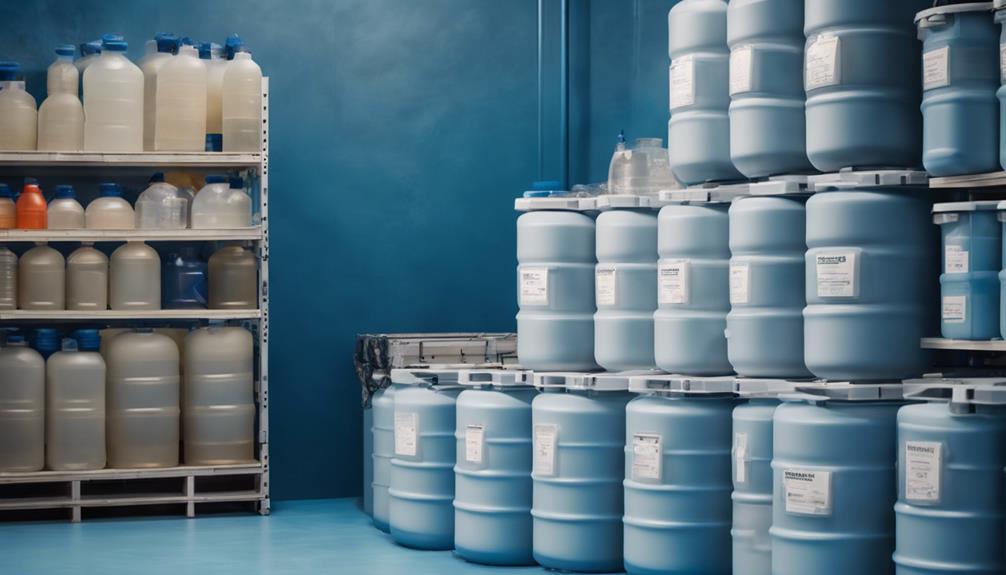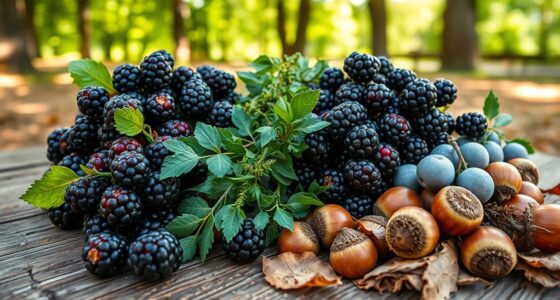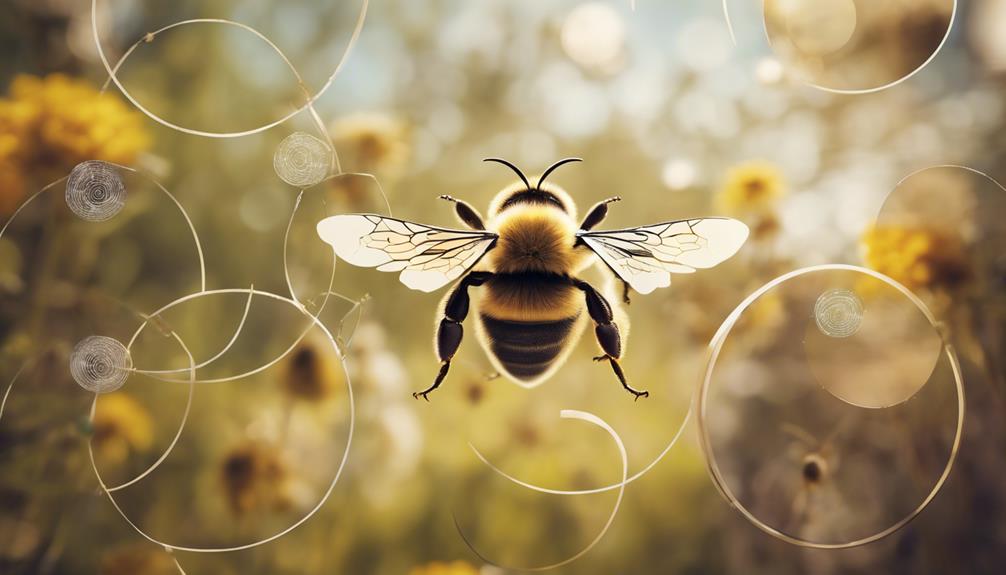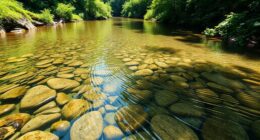When it comes to water storage for preppers, you'll want to prioritize durability, contamination prevention, and accessibility. Choose containers made from food-grade HDPE or PET plastic, stainless steel, or glass, ensuring secure lids and narrow openings. Store water in airtight containers, rotating every 6-12 months, and keep them in a cool, dark place. Familiarize yourself with local water sources, purification methods, and storage options. By understanding your terrain and implementing a rotational storage system, you'll be better equipped to maintain a reliable emergency water supply. As you continue on this path, you'll discover more strategies for ensuring your water storage plan is thorough and effective.
Key Takeaways
- Choose durable, food-grade containers like HDPE, PET, stainless steel, or glass to store water safely and prevent contamination.
- Rotate stored water every 6-12 months to maintain freshness and prevent bacterial growth.
- Store water in a cool, dark place and add purification methods like bleach or UV purifiers to ensure safety.
- Consider large water barrels and implement rotational storage systems to maintain water quality and prevent stagnation.
- Regularly inspect and maintain containers, as well as replenish stored water, to ensure a reliable emergency supply.
Choosing the Right Containers
When selecting containers for storing water, you'll want to choose options that are safe, durable, and easy to maintain, such as food-grade HDPE or PET plastic, stainless steel, or glass containers. These materials are ideal for storing water because they're non-toxic and resistant to corrosion, guaranteeing the water remains safe to use.
When evaluating containers, look for features like secure lids, narrow openings, and stable bases that prevent spills and contamination. Additionally, consider the durability and risk of breakage when choosing glass containers for long-term water storage.
Stainless steel containers are another great option, as they reduce the risk of chemical contamination in stored water. Finally, check for specific recycling numbers on plastic containers to ensure they're made from safe, high-quality materials like HDPE or PET.
Safely Storing Emergency Water

Now that you've selected the right containers, it's time to focus on securely storing your emergency water supply to guarantee it remains potable and accessible when you need it most. Proper storage is vital to maintaining the quality and safety of your stored water supply. Here are some essential Water Storage Tips to keep in mind:
| Storage Tip | Reason | Benefit |
|---|---|---|
| Store in airtight, food-grade containers | Prevent contamination | Keeps water fresh and safe |
| Rotate stored water every 6-12 months | Ensure freshness and quality | Maintains water's potability |
| Keep containers in a cool, dark place | Prevents bacterial growth | Reduces risk of contamination |
| Label water storage containers | Easy tracking and maintenance | Simplifies rotation and monitoring |
Purifying Emergency Water Storage

Purifying your emergency water storage is vital to guaranteeing access to safe drinking water during a crisis. You can't assume that your stored water is safe to drink without proper purification.
When dealing with emergency water storage, always consider the importance of having clean, purified water readily available for use.
For untreated water, adding 16 drops of bleach per gallon is an effective method of purifying water. However, this isn't the only option. Other purification methods for emergency water include filtration through portable filters or chemical options like purification tablets.
It's essential to make sure that emergency water is safe to drink or use for hygiene by following proper purification methods. Various water purification options, such as UV purifiers or gravity filters, can effectively treat emergency water for consumption.
Finding Water in the Wild

You can find alternative water sources in the wild, such as rivers, streams, and lakes, which can be used for drinking or purification after proper treatment.
When finding water in the wild, you need to know how to identify potential sources of water and know how to purify them.
Rainwater can be collected from natural sources like leaves, rocks, or makeshift gutters, providing a valuable source of water. However, it's crucial to avoid brackish or saltwater sources for drinking, using them instead for non-potable purposes like flushing or cleaning.
Well water can serve as a sustainable backup water source in the wild, but you need to test and treat it properly.
To Purify Water, utilize natural filtration methods like cloth or sand to remove debris before treating the water.
By knowing how to find and purify water in the wild, you'll be better equipped to survive in emergency situations.
Knowing Your Local Terrain

Getting to know the water sources in the local terrain, such as rivers, lakes, and retention ponds, is essential for developing a reliable emergency water plan. You'll want to familiarize yourself with the available water sources in your area, understanding their quality and accessibility to determine the best sources for emergency use.
Identify potential risks of contamination in local water sources to prioritize purification methods. Consider natural water filtration options like sand or charcoal filters when utilizing local water sources.
When planning ahead, map out water sources and develop strategies for efficient collection and purification during emergencies. This will enable you to store water safely and effectively, ensuring a dependable supply for emergency use.
Don't overlook the importance of knowing your local terrain; it's critical to your emergency water plan. By understanding your local water sources, you can develop a more thorough plan, including purification methods and efficient collection strategies. This knowledge will help you store water safely and effectively, providing a reliable supply for emergency use.
Calculating Water Storage Needs

Now that you've mapped out local water sources, it's time to determine how much water you'll need to store for emergency use. Calculating your water storage needs is essential to make sure you have enough for drinking, sanitation, and other essential uses.
A general rule of thumb is to store at least 1 gallon per person per day, but you may need to double that for sanitation needs during emergencies. Don't forget to factor in additional water for pets, medical needs, and special circumstances. Take into account storing at least a 3-day supply of water for each family member, and adjust your calculations based on your climate, family size, and potential alternative water sources.
To Calculate water storage, start by identifying your specific needs. For example, if you have a family of four, you'll need at least 4 gallons of water per day, and 12 gallons for a 3-day supply. Remember to take into account your unique circumstances and adjust your calculations accordingly.
Prepper Water Storage Options

Frequently, preppers opt for versatile and reliable water storage solutions that can hold sufficient quantities of water for emergency situations. When selecting a storage option, consider factors like cost, storage space, and material.
For instance, you can choose from 5-gallon containers, 55-gallon barrels, or even use a Water Bob for bathtub storage. Storing water in food-grade containers, such as tanks made of polyethylene, is crucial to guarantee the water remains safe for consumption.
As a prepper, you'll want to store at least one gallon of water per person per day, so calculate your needs accordingly. Alternative storage containers like bottles, reusable containers, and stackable tanks can also be used.
Remember to store your water in cool, dark, dry places to prevent contamination and spoilage. By selecting the right storage option and following proper storage guidelines, you'll be well-prepared for emergency situations.
Portable Water Filtration Methods

As you explore portable water filtration methods, you'll need to take into account the different types of filters available, each with their own strengths and weaknesses.
You'll want to compare the effectiveness of options like water purification tablets, UV purifiers, gravity filters, and chemical treatments to determine which ones best fit your needs.
Filter Types Compared
Compare portable water filtration methods, such as pump systems like the Cadan pump and gravity systems like the Berky, to find the best fit for your prepping needs.
When choosing a portable water filtration method, consider the filtration capacity, ease of use, and maintenance requirements. Pump systems, like the Cadan pump, can deliver purified water quickly to multiple users, making them ideal for group settings.
On the other hand, gravity systems, such as the Berky, provide a more passive approach to water filtration. Additionally, water bottles with built-in filters offer convenient on-the-go filtration for hikers and campers.
However, some filtration methods may be more challenging for children or elderly individuals to use effectively. Understanding the strengths and weaknesses of each filter type will help you select the right portable water filtration method for your specific needs.
Effective Filter Maintenance
To guarantee that your portable water filter continues to provide safe drinking water, you must regularly clean and maintain it according to the manufacturer's instructions. This guarantees peak performance, longevity, and effectiveness in removing contaminants from your water supply.
Here are some essential filter maintenance tips to keep in mind:
- Inspect and clean your filter regularly:
Check for clogs, wear and tear, and damage that may affect filtration efficiency.
- Follow the manufacturer's maintenance schedule:
This may include backwashing, flushing, and replacing filter elements.
- Store your filter properly:
Keep it in a clean, dry place to prevent contamination and preserve its effectiveness.
- Keep spare parts and cleaning supplies handy:
This ensures quick maintenance and minimizes interruptions in water filtration.
Long Term Water Storage Solutions

As you prepare for long-term water storage, you'll need to take into account several key factors to guarantee the water remains safe and potable.
You'll want to explore different storage container options, such as BPA-free plastic, stainless steel, or glass, that can withstand the test of time.
Additionally, you'll need to think about water treatment methods and rotational storage systems to maintain the quality of your stored water over an extended period.
Storage Container Options
When it comes to storing water for the long haul, you'll want to select storage containers that are durable, reliable, and designed to maintain water quality over time. Choosing the right container can make all the difference in storing water safely and efficiently.
Here are some top options to explore:
- Food-grade plastic containers: Look for HDPE or PET plastic containers with specific recycling numbers to reduce chemical leaching risks.
- Stainless steel tanks: A great option for long-term storage, stainless steel tanks are resistant to corrosion and chemical contamination.
- Glass bottles: While they can be used for extended storage periods, glass bottles are susceptible to breakage, so handle with care.
- Water barrels: Storing as much water as possible in large water barrels can be an effective way to stockpile water for emergencies.
Water Treatment Methods
You'll need to guarantee the water you've stored remains safe to drink, and that's where effective water treatment methods come in.
When it comes to long-term water storage solutions, boiling water is a reliable method that kills most pathogens.
Alternatively, water purification tablets can be used to treat stored water for extended periods.
If you prefer a more high-tech approach, UV water purifiers are efficient and eliminate bacteria, viruses, and protozoa.
For chemical treatments, bleach can be used to treat water in large storage containers for extended periods.
Finally, filter systems like ceramic or activated carbon filters are effective for maintaining water quality in long-term storage.
By incorporating these methods into your water storage plan, you can rest assured that your stored water remains safe and potable.
Remember, it's essential to prioritize water treatment to avoid waterborne illnesses.
Rotational Storage Systems
Implementing a rotational storage system is essential for maintaining a reliable and fresh emergency water supply, guaranteeing that your stored water remains safe to drink and free from contamination. By regularly rotating stored water, you can sustain freshness and prevent stagnant water, which can harbor harmful bacteria or algae. This method assures that your water supply remains safe and reliable, giving you peace of mind in case of an emergency.
Here are some key benefits of rotational storage systems:
- Maintains freshness: Regularly rotating stored water prevents stagnant water and keeps your supply fresh.
- Prevents contamination: Rotational storage helps prevent the growth of harmful bacteria or algae, ensuring your water is safe to drink.
- Ensures reliability: By consistently using and replenishing stored water, you can guarantee a reliable emergency water source.
- Peace of mind: Rotational storage systems provide long-term preparedness and peace of mind, knowing you have a safe and reliable water supply.
Maintaining Water Quality Standards

To maintain water quality standards, regularly sanitizing your water containers is essential to prevent contamination and keep your stored water safe for consumption. You can do this by mixing unscented bleach with water and using it to sanitize your containers every 3 to 6 months. This schedule will help prevent the growth of algae and bacteria that can cause waterborne diseases.
When cleaning your water storage containers, make sure to label them with the storage date and treatment information, so you can easily track and rotate your stock. It's also vital to store your water in dark, cool places to prevent algae growth, which can be accelerated by direct sunlight exposure.
Frequently Asked Questions
What Is the Best Way to Store Water for Prepping?
When storing water for prepping, you'll want to use sturdy, airtight, food-grade containers to prevent contamination, and consider portable options like water bricks or stackable tanks for easy storage.
How Do You Store Water for 100 Years?
To store water for 100 years, you'll need to use food-grade containers, treat the water properly, and rotate it every 6-12 months. Add a few drops of bleach to prevent bacterial growth, and store it in a cool, dark place.
What Is the Best Water for Preppers?
You'll want clean, potable water free from contaminants, so look for water that's been properly treated and filtered, and consider collecting rainwater or using a portable filtration system to guarantee a safe supply.
What to Add to Water for Long-Term Storage?
When storing water long-term, you'll want to add something to prevent bacterial growth. You can add 8 drops of unscented bleach per gallon or use water preserver concentrate for added protection.
Conclusion
As you gaze out at the horizon, envisioning a world where access to clean water is scarce, you're reminded that preparation is key to survival.
By now, you've learned the importance of choosing the right containers, purifying emergency water, and finding water in the wild.
Remember, maintaining water quality standards is vital.
With these essential tips and tricks, you're one step closer to being a self-sufficient prepper, ready to face any water crisis that comes your way. Remember, staying informed and continuously updating your skills is key to long-term preparedness. By incorporating Canadian prepping strategies, such as utilizing natural water sources and practicing strict water conservation methods, you can further enhance your readiness. Stay vigilant, adaptable, and proactive as you prepare for the unexpected challenges ahead. Additionally, don’t forget the importance of properly storing your water supplies and rotating them regularly to ensure freshness. By combining emergency water filtration systems with *Canadian prepping strategies*, like building rainwater collection systems and identifying local edible plants, you can secure sustainable resources for the long haul. Always remember, knowledge and preparation are your greatest tools in navigating uncertain times.










